POTTERY A HAND-BOOK OF PRACTICAL POTTERY FOR ART TEACHERS AND STUDENTS BY RICHARD LUNN INSTKUCTOK AT TIIE ROY.I. COI.LRIE OF AKT, bOUTli KEICSINGTON VOLUME I1 DECORATION OF POTTERY WITH 46 ILLUSTRATIONS LONDON CHAPMAN AND HALL, LTD. I g ro POTTEKY RICHAKD CLAY SONS, LIMITED, BREAD STREET HILL, E.C., AND BCNGAY, SUFFOLK. PREFACE THIS volume is illterlclecl to be supplementary to the earlier handbooli issued in 1903. That volume dealt chiefly with the making of shapes, vhile this is mainly concerned with decora- tion. The illustrations shot- examples of good work in the different nlrthods described, and among them Ire included photographs of a few decorators at work, to show convenietlt arrangements of fitting-S, etc. This b001i is rimarily inteldecl for beginrlers and students, and so may be found, in places, very elementary by those who lino Inore about practical potting. It is mainly based upon teaching given by the author to practical Iottery Classes at the Royal College of Art, and other Schools of Arts and Crafts. In conclusion I agaiil wish to espress my thanks to the officills of the Victoria and i2lbert Aluseum for their help in ai-rangin,r the objects for photo- graphing, anil for reliable measurements of the ware. I also wish espcciall- to thank AIr. G. H. Palnler for his help in revising the worli. CONTENTS CIIAI. I RI.ZTERIALS USEI IS EARTHEKIVARE PASTES I1 COIlPOSITION 01 F ITI-IINVARE BODIES 01 PASTE5 . 111 IOTTIIY DECOI.ITIOT I3IIUSBES, MEDIUlIS, AKD COLOURS . IY IIOW TO KEEP PII.CES IN ZOSITION YIlEK THEY ARE EEIiiG PAIXTED . 1- USDERGLAZE DECORATIOX . V1 GLAZES , 111 ENAIIEL OR 01-ERGLAZE DECOIIATIOK . V111 CIOUND-LAIISC . IS SLIIS AN11 COLOUIED P-ASTES, SLIP DECORA- TION, Xhl SGRAFFI.ITO . S XOTES ON THE 13XSIS OF SOME 01, THE CIIIEF CEIiAhIlC COLOUIiS . NOTE OS 1,IRISG . ILLUSTRATIONS OF POTTERY IN TIIE VIC- TORIA ASI ALBERT JIUSECI, SOUTH IiESSIiiGTOK . POTTERY CHAPTER I MATEIIIXLS USED IN EXRTHEhTiYARE PASTES Clays.-It may be said, generallj-, that the base of L clay consists of that portion of sorne of the minerals named felspars, vllicl remains after their partial dccomposition by atmospheric and other influences. This residue is a chemical combination of silica lvith alunina, and is termed silicate of alurnina. In all clays it is in a hydrated form, i.e. it is chemically cornlined with water which cannot be expelled by heating the compound to the boiling- point of water. Most clays contain, in addition to the hydrous silicate of alumina, a variable proportion of free silica and other substances in a state of mechanical as distinguished from chemical association with l POTTERY thenl. Of such admixtures, the potash, soda, lime, or oxide of iron, which may have been pfcsent in the original felspar, are remorred to a great extent in the form of soluble carbonates or bicarbonates b. the action of water holding carbon dioxide carbonic acid gas in solution. rhe Illanner io which a clay behaves on exposure to heat is greatly affected by these admixtures, Thus the presence of potash, lime or oxide of iron confers upon a clay a varying increase of fusibility, while additional silica renders it refractory, or difficult to fuse. Felspars constitute a portion, often considerable, of such crystalline rocks as granitc, porphyry, diorite and the like, and where such rocks exist, or have existed, clay nnay be found, for all felspars are liablc to decomposition under certain conditions so as to yield clay-forming materials. It is observabIe that those specics which are poorest in silica and contain tnuch lime decompose more readily than those which are richer in silica, and contain less lime, but more soda and potash, Kaolin or China clay.-Sometimes large masses the decomposed renlaits of felspars have been carried into cavities or depressions and there covered and drifted over with other materials of 2 EARTHENWARE PASTES the origiilal rock...








